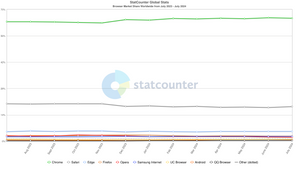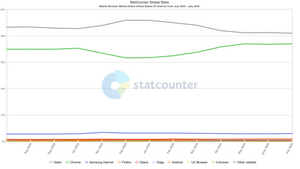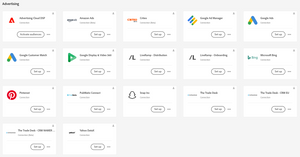
The End of the Cookie Drama
26 Aug 2024 » Opinion
As a small kid, I loved watching Sesame Street. One of my favorite characters was the Cookie Monster. I liked how he would try to eat as many cookies as possible, creating a mess. I later heard that there was an initiative to make him eat vegetables and fruits, but I never saw it and I do not know how true that statement was. Returning to the mess, this is a very accurate picture of what we have today with browser cookies, especially third-party cookies.
I have written multiple times about cookies, from the basic technical details to the expected deprecation of third-party cookies to the extra time for third-party cookies. Yet, in a recent plot twist from Google, it turns out that Chrome will finally not deprecate third-party cookies, putting to bed any initiatives of doing so.
TL;DR
In case you have not been following the cookies soap opera, Google announced a few years ago that they would deprecate third-party cookies and gave an initial deadline. Some time later, they said they needed more time, pushing back the deadline. Finally, Google has said that they will not deprecate third-party cookies, but will offer more transparency.
Reasons behind the decision
Obviously, the real reasons for this change have not been shared with the public. Their marketing department has been very busy finding some nice wording. However, I do not think it has surprised us in the MarTech industry.
If I ask anybody not familiar with this industry, what Google’s core business is, I will get answers like: a search engine, a maps provider, a video platform, all of the above… You and I know that these answers are wrong: Google is an advertising platform, a huge advertising platform, and the media is all their products: search engine, maps, YouTube, Gmail, and others.
This finally takes me to the cookies. The only way to create audiences of anonymous visitors in tools like Data Management Platforms (DMP) and share them with Google or any other Demand Side Platforms (DSP) is through third-party cookies and ID syncs. Google would take a huge hit in their profit if they blocked these cookies. Therefore, the decision they have just made is actually a no-brainer.
In case you are wondering, Google also offers other options to share known audiences, like Google Customer Match. These solutions use email addresses or phone numbers as keys. For obvious reasons, this only works if the advertiser knows these attributes from the visitor. The problem that I am describing above is with unknown or anonymous visitors, from who we do not have any knowledge.
So, now what?
With all these ebbs and flows, I am sure many advertisers are wondering what to do. I cannot blame them, I would too. To me, it is clear that you need to protect yourself from any eventuality; things can change quicker than you expect. These are my recommendations.
Technology
Now that third-party cookies are back in good shape, use them wisely. If you have a DMP like Adobe Audience Manager (AAM), give it a second opportunity. I am actually surprised to recommend again AAM, as it was facing a steady decline when Google first announced the deprecation of third-party cookies. Remember that it is a tool that pays for itself and it is very robust, so take advantage of it while you can.
However, and for the more general case, I strongly recommend investing in a Customer Data Platform (CDP) like Adobe Experience Platform (AEP). This will force you to think in terms of first-party data, give you greater flexibility, and isolate you a bit more from the undesired changes in the advertising market.
Follow browser market share
Google is in a dominant position and takes advantage of that, as they not only offer advertising platforms but also a browser. This means that they are controlling both sides of the equation, making sure that their advertising technology is as efficient as possible. In case are not following me, Google Chrome has third-party cookies enabled by default, something that many other browsers either disable or limit significantly.
At the moment of writing, Google Chrome has an approximate market share of 65% of all browsers. In other words, about 65% of your anonymous visitors can be confidently targeted using Google’s DSP (DV360).
However, you should not get complacent by the previous statistics. If I break it down and look at the mobile visitors in the USA, the picture changes drastically:
Safari leads by a healthy margin and this browser is very restrictive with third-party cookies.
This explanation leads to my next recommendation. Do the following steps every few months:
- Understand what each browser does with third-party cookies and check the evolution.
- Keep track of the browsers used by your visitors. Do not stay high level, but do useful breakdowns.
- Follow the legal changes in your markets. Many governments love to regulate everything they can.
- Track the traffic and ROI of your marketing initiatives, using tools like Marketing Channels.
Once you have this information, you can evaluate how profitable DSPs are for you. The moment they are not profitable, this probably means that your visitors and customers are mostly blocking third-party cookies.
Diversify your advertising
Most of my clients have a healthy mix of advertising platforms. And they do it for a reason: they do not want to put all their eggs in the same basket. I see this as a wise move and I would recommend everybody to do the same.
If you have a CDP like AEP, this diversification is very easy. You can create a segment and share it with any of the supported destinations. The only condition is to make sure you have the keys the destination requires. As an example, at the moment of writing, AEP has out-of-the-box integrations with:
Not only you should diversify the number of platforms you use, but also try to use more advertising platforms that rely on first-party data. This will allow you to be more immune to any future decline of third-party cookies.


